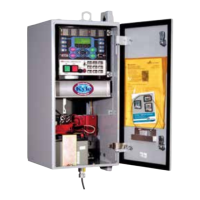Communication Board Accessories
The Form 6 pole-mount control is equipped with a
Communication Board Accessory (expansion bay) offering
versatile support for modern communication media. Six
distinct communication options (Figure 38) are available,
providing two-way, real time digital communications with a
remote terminal unit (RTU), wireless, telephone modem,
Ethernet network, or other communication devices. The
following options are available:
• No auxiliary communication card installed (standard)
• RS485 (isolated) Serial communication card
• Fiber-optic-based Serial Communication Card (ST)
• 10/100 Base-T dual Ethernet communication card
(2*RJ-45)
• 100 Base-FX dual Ethernet communication card (2*MT-
RJ)
• 10/100 Base-T, 100 Base-FX Ethernet communication
card (RJ-45 + MT-RJ)
The expansion bay based Communication Board Accessory
concept offers high versatility with respect to communication
medium and protocol support. Additional accessories are
being continuously developed. Contact your Cooper Power
Systems representative for the latest information regarding
particular media and communication protocol support.
RS485 Serial Communication Card
The RS485 serial communication card accessory provides
means for establishing asynchronous link-based digital
communications with the Form 6 pole-mount control. The
Galvanic isolated (1000V DC) RS485 port uses a single
shielded twisted pair connection and can support 32
devices in multi-drop configuration. Communication speed
is controlled through software and can be set at: 1200,
2400, 4800, 9600, 19.2k, and 38.4k. Modbus can also be
set at 57.6k.
Digital communications must be programmed through the
Communications Workbench to ensure proper operation of
the RS485 communication card accessory. Refer to
Service Information S280-70-4 (ProView 4.X.X) or S280-
70-21 (ProView 5.X.X) Form 6 Microprocessor-Based
Recloser Control Programming Guide for additional proto-
col support information.
Fiber-Optic Based Serial Communication
Card
The Fiber-Optic based Serial Communication Card offers
means of establishing asynchronous (RS-232 like) digital
communications through multi-mode fiber media. The use
of the fiber-optic based serial communication card acces-
sory can enhance communication reliability, and provides
excellent electrical isolation thus protecting transmitted
data from extraneous electrical interference.
An optional fiber-optic-to-RS-232D converter with DB-9
connector (Catalog Number KME6-1875-1) is available for
interfacing between an optical signal and a hard-wired
RS-232 signal, when required. This converter is compatible
with loop (ring) and point-to-point (star) configurations.
A pair of industry standard ST type fiber-optic connectors
are mounted on the back of the board enabling customer
connection to a digital communication system using fiber-
optic cables (customer-supplied).
The fiber-optic link has separate receive (RX) and transmit
(TX) ports operating at 820nm. Typical transmission dis-
tance is 2000m with 62.5/125µm multi-mode fiber. Consult
your Cooper Power Systems representative for availability
of long haul solutions. Link communication speed is con-
trolled through software and can be set at: 1200, 2400,
4800, 9600, 19.2k, and 38.4k. Modbus can also be set at
57.6k.
The fiber-optic accessory must be programmed through
the Communications Workbench for the appropriate proto-
col. Refer to Service Information S280-70-4 (ProView
4.X.X) or S280-70-21 (ProView 5.X.X) Form 6
Microprocessor-Based Recloser Control Programming
Guide for additional information.
The fiber-optic based serial accessory includes TX and RX
indicating LEDs for verifying communications along with an
echo / non echo switch for supporting ring / star fiber
topologies.
When operated in a ring configuration, the toggle switch
must be set in the ECHO position. In this mode, the fiber-
optic card will repeat (pass through) all messages received
on the RX fiber, and will respond to the Master station by
first echoing the incoming command and then sending the
response. This arrangement is best suited for creation of
low cost multi device fiber loops. For reliable communica-
tions, the fiber loop system requires that all devices in the
loop remain powered at all times, thus enabling unob-
structed flow of information throughout the loop.
A more resilient system can be designed by using the
fiber-optic ports in a point-to-point or multiple point-to-
point (star) configuration. For this mode, the toggle switch
must be set in the NON-ECHO mode. The Form 6 pole-
mount control will respond to the Master station by send-
ing a response only (total separation of Receive and
Transmit fibers). Additional hardware (fiber-optic star cou-
pler) is required to support the multiple point-to-point
device configurations.
Ethernet Communication Cards
The Ethernet communication card accessory brings the
Ethernet network connectivity to the Form 6 pole-mount
recloser control platform. It is highly flexible, offering simul-
taneous support for multiple sessions, device management
(ProView over TCP/IP) and SCADA communications (DNP3
over TCP/IP).
By natively supporting a set of widely accepted industry
standards (TCP/IP, UDP/IP, OSI) the Ethernet communica-
tion accessory ensures seamless interoperability with other
network devices.
S280-70-3
43

